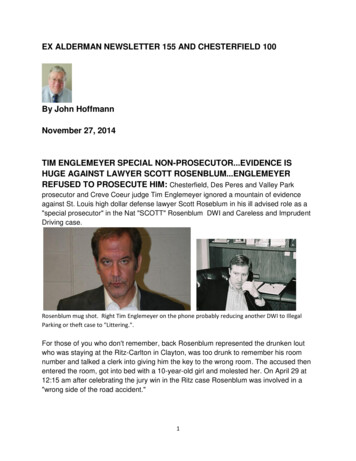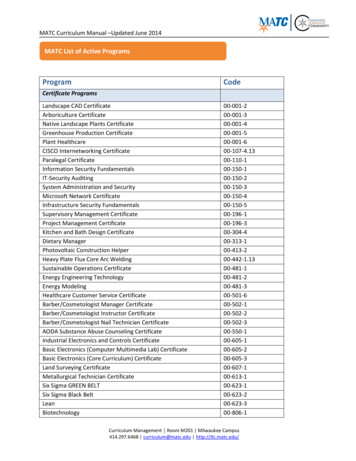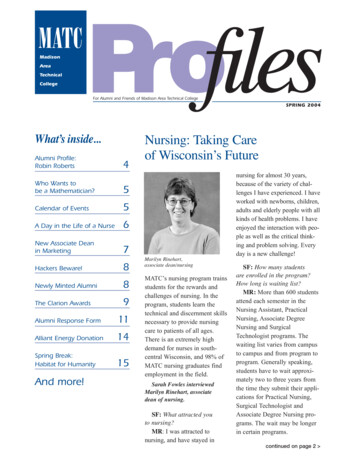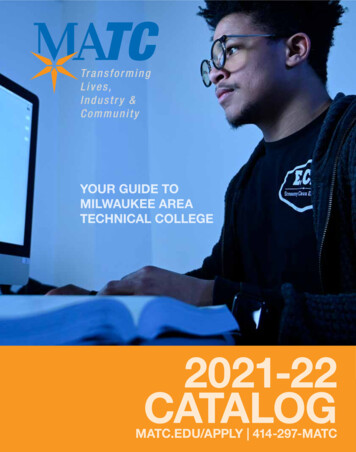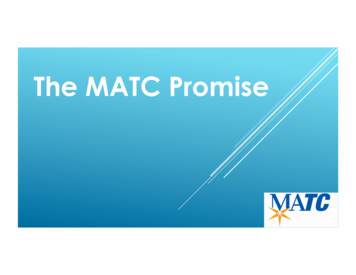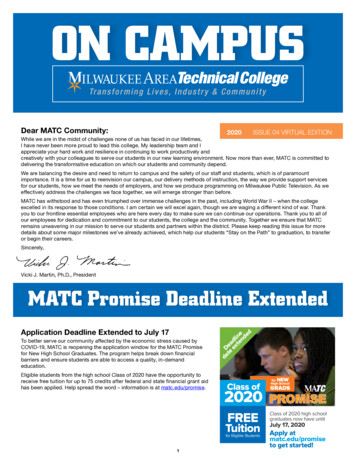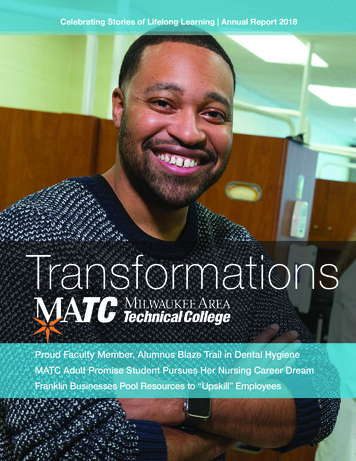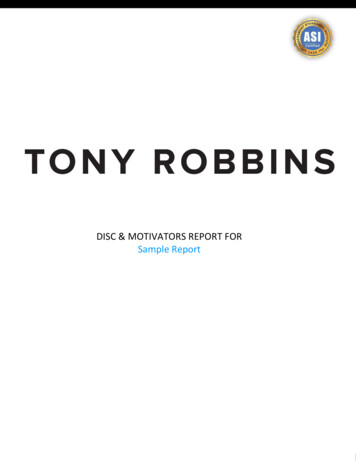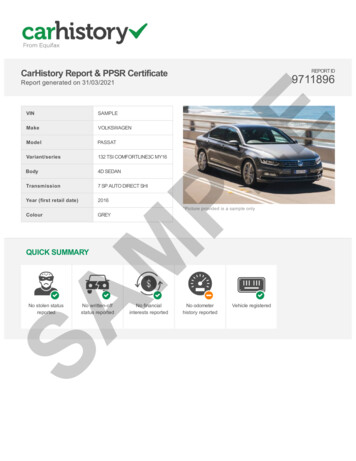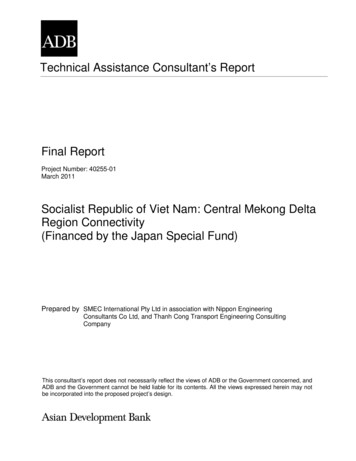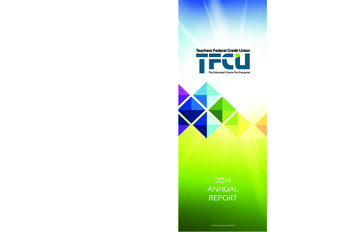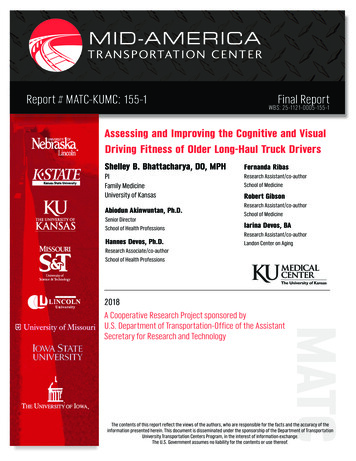
Transcription
Report # MATC-KUMC: 155-1 Final ReportWBS: 25-1121-0005-155-1Assessing and Improving the Cognitive and VisualDriving Fitness of Older Long-Haul Truck DriversShelley B. Bhattacharya, DO, MPHFernanda RibasPIFamily MedicineUniversity of KansasResearch Assistant/co-authorSchool of MedicineAbiodun Akinwuntan, Ph.D.Senior DirectorSchool of Health ProfessionsHannes Devos, Ph.D.Robert GibsonResearch Assistant/co-authorSchool of MedicineIarina Devos, BAResearch Assistant/co-authorLandon Center on AgingResearch Associate/co-authorSchool of Health Professions2018A Cooperative Research Project sponsored byU.S. Department of Transportation-Office of the AssistantSecretary for Research and TechnologyThe contents of this report reflect the views of the authors, who are responsible for the facts and the accuracy of theinformation presented herein. This document is disseminated under the sponsorship of the Department of TransportationUniversity Transportation Centers Program, in the interest of information exchange.The U.S. Government assumes no liability for the contents or use thereof.
Assessing and Improving the Cognitive and Visual Driving Fitness of Older Long-HaulTruck DriversShelley B. Bhattacharya, DO, MPHTitle: PIDepartment: University of Kansas, FamilyMedicineFernanda RibasTitle: Research Assistant/co-authorDepartment: University of Kansas, Schoolof MedicineAbiodun Akinwuntan, PhDTitle: Senior DirectorDepartment: University of Kansas, Schoolof Health ProfessionsRobert GibsonTitle: Research Assistant/co-authorDepartment: University of Kansas, Schoolof MedicineHannes Devos, PhDTitle: Research Associate/co-authorDepartment: University of Kansas, Schoolof Health ProfessionsIarina Devos, BATitle: Research Administrative AssociateDepartment: University of Kansas, LandonCenter on AgingA Report on Research Sponsored byMid-America Transportation CenterUniversity of Nebraska–LincolnJuly 30, 2018
TECHNICAL REPORT DOCUMENTATION PAGE1. Report No.2. Government Accession No.25-1121-0005-155-14. Title and SubtitleAssessing and Improving the Cognitive and Visual Driving Fitness of Older LongHaul Truck Drivers3. Recipient’s Catalog No.7. Author(s)Shelley B. Bhattacharya https://orcid.org/0000-0001-7785-6446Abiodun Akinwuntan https://orcid.org/0000-0002-0167-685XHannes Devos, Fernanda Ribas, Robert Gibson, and Iarina Devos9. Performing Organization Name and AddressUniversity of Kansas Medical Center3901 Rainbow Blvd.Kansas City, KS 661608. Performing Organization Report No.25-1121-0005-155-112. Sponsoring Agency Name and AddressOffice of the Assistant Secretary for Research and Technology1200 New Jersey Avenue, SEWashington, DC 20590 United States13. Type of Report and Period CoveredMATC Final Report, Year 15. Report DateJuly 30, 20186. Performing Organization Code10. Work Unit No.11. Contract or Grant No.69A3551747107, Subaward with theUniversity of Kansas, Lawrence14. Sponsoring Agency CodeRiP No. 91994-1115. Supplementary NotesConducted in cooperation with the U.S. Department of Transportation, Federal Highway Administration.16. AbstractDriving is a highly dynamic task that requires intact cognitive and visual skills to perform safely. Driving trucks loadedwith hazardous materials requires even more careful planning and consideration to avoid unanticipated shifts in the center ofgravity associated with sharp turns while speeding (slushing) or liquid surge associated with sharp braking. Such planning andconsideration are highly dependent on cognitive and visual skills for accuracy. In the first year of this proposal, we developed adriving fitness assessment battery that consisted of tests that have been shown in the geriatric literature to be reliable and validmeasures of driving-related cognitive and visual skills in older adults. These tests consist of the Snellen Maze Test, Trails A and B,Range of Motion and Gait Speed. Cognitively, the Mini Mental Status Examination (MMSE) has had significant limitations indriving fitness; therefore, alternative cognitive tools such as theSaint Louis University Mental Status (SLUMS) and MontrealCognitive Assessment (MoCA) exam were included, if appropriate. Drivers with a Commercial Driver’s License (CDL) will berecruited and given this battery of tests to: 1) Assess their cognitive and visual fitness, 2) establish the usefulness and effectivenessof these tests to drivers before embarking on the journey, and 3) identify potential risk factors that contribute to unsafe driving.This is Year 1 of a five-year grant. Over the course of the grant, we anticipate the study will be helpful in identifying drivers whohave cognitive and/or visual impairments that may make driving a truck, especially one carrying hazardous materials, unsafe. Aunique aspect of this part of the study is the possibility of improving driving fitness by offering drivers with demonstratedcognitive and visual deficits the opportunity to retrain and improve such skills in a technologically advanced high-fidelitysimulator.17. Key WordsSafety and Security: Safety (Ha), Crashes (Hb), Risk (Hk)19. Security Classif. (of this report)Unclassified18. Distribution StatementNo restrictions.20. Security Classif. (of thispage)ClassifiedForm DOT F 1700.7 (8-72)21. No. of Pages10Reproduction of completed page authorizedii
Table of ContentsAcknowledgments. ivDisclaimer . vAbstract . viChapter 1 Purpose, Background, Rationale . 11.1 Aim and Hypothesis . 21.2 Study Significance . 21.3 Literature Review. 3Chapter 2 Methodology and Findings .62.1 Methodology and Study Proceedings 62.2 Findings and Revisions . 8Chapter 3 Conclusions and Recommendations. 9References .10ii
List of AbbreviationsCommercial Driver’s License (CDL)Commercial Motor Vehicle (CMV)Federal Motor Carrier Safety Administration (FMCSA)Iowa Department of Transportation (IaDOT)Kansas Department of Transportation (KDOT)Mid-America Transportation Center (MATC)Missouri Department of Transportation (MoDOT)National Institute for Occupational Safety and Health (NIOSH)Nebraska Department of Roads (NDOR)Nebraska Transportation Center (NTC)Transportation Research Board of the National Academies (TRB)University Transportation Center (UTC)United States Department of Transportation (USDOT)Useful Field of View (UFOV)iii
AcknowledgmentsThis project would not have been possible without the unity of our research team and ourcollaborative relationship with Dr. Larry Rilett from the University of Nebraska-Lincoln.iv
DisclaimerThe contents of this report reflect the views of the authors, who are responsible for thefacts and the accuracy of the information presented herein. This document is disseminated in theinterest of information exchange. The report is funded, partially or entirely, by a grant from theU.S. Department of Transportation’s University Transportation Centers Program. However, theU.S. Government assumes no liability for the contents or use thereof.v
AbstractDriving is a highly dynamic task that requires intact cognitive and visual skills to performsafely. Driving trucks loaded with hazardous materials requires even more careful planning andconsideration to avoid unanticipated shifts in the center of gravity associated with sharp turnswhile speeding (slushing) or liquid surge associated with sharp braking. Such planning andconsideration are highly dependent on cognitive and visual skills for accuracy. In the first year ofthis proposal, we developed a driving fitness assessment battery that consisted of tests that havebeen shown in the geriatric literature to be reliable and valid measures of driving-relatedcognitive and visual skills in older adults. These tests consist of the Snellen Maze Test, Trails Aand B, Range of Motion and Gait Speed. Cognitively, the Mini Mental Status Examination(MMSE) has had significant limitations in driving fitness; therefore, alternative cognitive toolssuch as the Useful Field of View (UFOV) exam were included.Drivers with a Commercial Driver’s License (CDL) will be recruited and given thisbattery of tests to: 1) Assess their cognitive and visual fitness, 2) establish the usefulness andeffectiveness of these tests to drivers before embarking on the journey, and 3) identify potentialrisk factors that contribute to unsafe driving. This is Year 1 of a five-year grant. Over the courseof the grant, we anticipate the study will be helpful in identifying drivers who have cognitiveand/or visual impairments that may make driving a truck, especially one carrying hazardousmaterials, unsafe. A unique aspect of this part of the study is the possibility of improving drivingfitness by offering drivers with demonstrated cognitive and visual deficits the opportunity toretrain and improve such skills in a technologically advanced high-fidelity simulator.vi
Chapter 1 Purpose, Background, and RationaleOne of the cardinal missions of the Federal Motor Carrier Safety Administration(FMCSA) of the United States Department of Transportation is to improve safety on our nation'shighways. That includes reducing the number of accidents that involve commercial truck drivers,including hazardous and non-hazardous material transportation. Such accidents have a highpotential to cause serious harm to the public and the environment. In addition to the severalinitiatives that have been put in place by the FMCSA to reduce accidents involving truckshauling hazardous materials, there is a need to (i) improve driving fitness by determining thecognitive and visual fitness, and rehabilitating pertinent components of drivers who drivecommercial vehicles; (ii) develop a sensitive measure of cognitive and visual alertness that canindicate cognitive overload capable of resulting in an accident; (iii) using a simulator, begindesign of an alert system that will notify all emergency medical services within a specific radiusof an accident of the nature of the hazardous materials being hauled by the commercial vehicleand the extent of damage.The Mid-America Transportation Center (MATC) was designated by the United StatesDepartment of Transportation as the Region VII University Transportation Center (UTC) in2017. MATC is a consortium comprised of the University of Nebraska Lincoln, University ofNebraska-Omaha, University of Nebraska-Medical Center, University of Kansas, University ofKansas-Medical Center, Missouri University of Science and Technology, University of Iowa,Nebraska Indian Community College, and Lincoln University. MATC’s partners include theIowa Department of Transportation (IaDOT), the Kansas Department of Transportation (KDOT),Missouri Department of Transportation (MoDOT), the Nebraska Department of Roads (NDOR),1
the United States Department of Transportation (USDOT), and various private and public sectortransportation organizations.This project is needed to meet MATC’s vision to become a nationally recognized centerof transportation excellence focused on developing new knowledge, innovative solutions, and thenext generation of transportation professionals necessary to sustain the U.S. transportationsystem in a manner that is safer, more effective, more efficient, environmentally friendly, andsustainable. Older drivers are becoming increasingly prominent, maintaining their cognitive andvisual fitness is essential for their safety and the safety of others sharing the road.1.1 Aim and HypothesesDriving is a highly dynamic task that requires intact cognitive and visual skills to performsafely. Driving commercial vehicles that are loaded with hazardous materials requires even morecareful planning and consideration to avoid unanticipated shifts in the center of gravityassociated with sharp turns while speeding (slushing) or liquid surge associated with sharpbraking. Such planning and consideration are highly dependent on cognitive and visual skills foraccuracy.By doing this study we hope to: A. Assess CDL drivers’ cognitive and visual fitness, B.Establish the usefulness and effectiveness of these tests to drivers before embarking on thejourney, C. identify potential risk factors that contribute to unsafe driving, and D. Evaluate theeffect of an intervention program to improve reduced visual, cognitive, and driving skills1.2 Study SignificanceWe anticipate that this study will be helpful in identifying CDL drivers who havecognitive and/or visual impairments that may make driving a commercial vehicle, includingthose carrying hazardous materials, unsafe. A unique aspect of this part of the study is the2
possibility of improving driving fitness by offering drivers with demonstrated cognitive andvisual deficits the opportunity to retrain and improve such skills in a technologically advancedhigh-fidelity simulator.Moreover, this project will also meet Mid-America Transportation Center (MATC)’sresearch goal to make fundamental advancements in basic and theoretical research related toimproving the safety of the US and Region VII transportation systems. A key focus is to ensurethat this research product will be implemented by regional and national transportation agencies.1.3 Literature ReviewThere are approximately 1.7 million long-haul truck drivers in the USA, either for hire orin private fleets (Hege et al., 2015). Truck driving is the second most common occupation in theUSA (following retail sales), employing 1 in 35 adult men. Commercial motor vehicle (CMV)drivers make up a substantial proportion of the workforce, however, it is anticipated there will beshortage of drivers in the coming years in the USA. Many studies in the US have examined crashrisk in CMV (Chen & Xie, 2014). Data from the US show that truck drivers account for 16–20%of all crashes, costing billions of dollars annually (Mayhew et al., 2011). While reducing thenumber of injurious and fatal accidents is paramount to public safety, determining causativefactors are equally important in reducing crash risk.One review found associations between fatigue and crash risk as well as other factorsrelated to truck design and maintenance, such as unsecure cargo and weather conditions (Robb,Sultana, Ameratunga, & Jackson, 2008). Yet, this review was not inclusive of long-haul truckdrivers; it included taxi drivers, professional drivers, company car drivers, as well as studiesrelated to medical personnel and nurses. The review also included studies from countries that arenot similar to the North American context (Robb et al., 2008).3
Recent US studies show that factors related to demographics as well as health andwellness are associated with crash risk including age, gender (men), low back pain,cardiovascular disease, stress, untreated sleep apnea and diabetes, as well as obesity(Apostolopoulos et al., 2012; Apostolopoulos, Sonmez, Shattell, & Belzer, 2010; Apostolopouloset al., 2011). Thus, CMV drivers are considered a vulnerable or high-risk segment of thepopulation by the US Federal Motor Carrier Safety Administration (FMCSA), the TransportationResearch Board of the National Academies (TRB), and the National Institute for OccupationalSafety and Health (NIOSH). CMV drivers are plagued with high rates of disease often attributeddirectly to the nature of the job (Lemke, Apostolopoulos, Hege, Sönmez, & Wideman, 2016).The work environment exposes both truck and bus drivers to long work hours (up to 14h/day), prolonged sitting, excessive noise and vibration and generally unhealthy lifestyles(Lemke et al., 2016). Truck drivers are more likely to use tobacco, to be physically inactive, tohave poor diets, and to have disrupted sleep cycles and higher levels of stress), leading to anincreased risk of cardiovascular disease, psychological and musculoskeletal disorders (MSDs)compared to the general population (Apostolopoulos et al., 2012). These risk factors andconditions, particularly among long-haul drivers, can produce work-place injuries and impactwork productivity and driving performance.Taking the above factors into consideration, the average life expectancy of truck driversin the US is 12–20 years lower than the general population (Crizzle et al., 2017). The firstInternational Conference on Commercial Driver Health and Wellness was sponsored by theFMCSA, The US Department of Transportation and NIOSH in 2010. Several priority areasemerged from this conference, particularly the need for a better understanding of the combined4
impact of multiple risk factors (i.e., irregular schedules, long hours of work, poor diet andnutrition, stress) on driver health and wellness, as well as productivity and safety.While there is consensus that CMV drivers are an at-risk population for poorer health,there has been no critical appraisal of the motor, cognitive, and visual determinants of drivingsafety. This study will delve into this arena. Second, rehabilitation strategies to improve thesedriving-related impairments will be explored.5
Chapter 2 Methodology and FindingsDrivers over age 18 licensed to drive commercial vehicles (i.e: possessing CDL licenses)will be recruited and given a series of tests to: 1) Assess their cognitive and visual fitness, 2)Establish the usefulness and effectiveness of these tests to drivers before embarking on thejourney, and 3) Identify potential risk factors that contribute to unsafe driving. Consequently, aprospective case series will be the study design. The sample size over the course of the 5 yearproject will be 250 (approximately 85 annually), with each participant being given the same testsbut in randomized order to prevent bias and to limit confounding factors. Participants who areunable to provide written informed consent or attend all testing sessions when scheduled will beexcluded from the study results. Additionally, there will not be any laboratory testing involved inthis study.2.1 Methodology and Study ProcedureEach study participant will undergo all procedures and tests on the same day. Theestimated time for testing evaluation, excluding informed consent overview, will be no morethan two hours. Informed consent will be obtained prior to participants’ participation in thestudy, at the scheduled time of their testing session. The informed consent document will detailthe procedures and right of the individual partaking in the study. Any subject who finds theprocedures objectionable for any reason will be given the opportunity to terminate participationas described above. In addition, subjects will be informed that they can discuss any questionsthey have about the research procedures or their performance with the experimenter. In addition,prior to beginning each testing session, demographic and clinical information including age, sex,BMI, blood pressure, level of education, and driving history will be collected for eachparticipant.6
As a part of each participant’s scheduled testing session, they will undergo a series ofcognitive, visual and physical assessments. These assessments include the following:2.1.1 Cognitive assessment (20 minutes)The cognitive ass
The Mid-America Transportation Center (MATC) was designated by the United States Department of Transportation as the Region VII University Transportation Center (UTC) in 2017. MATC is a consortium comprised of the University of Nebraska Lincoln, University of Nebraska-Omaha, University of Nebraska-Med
